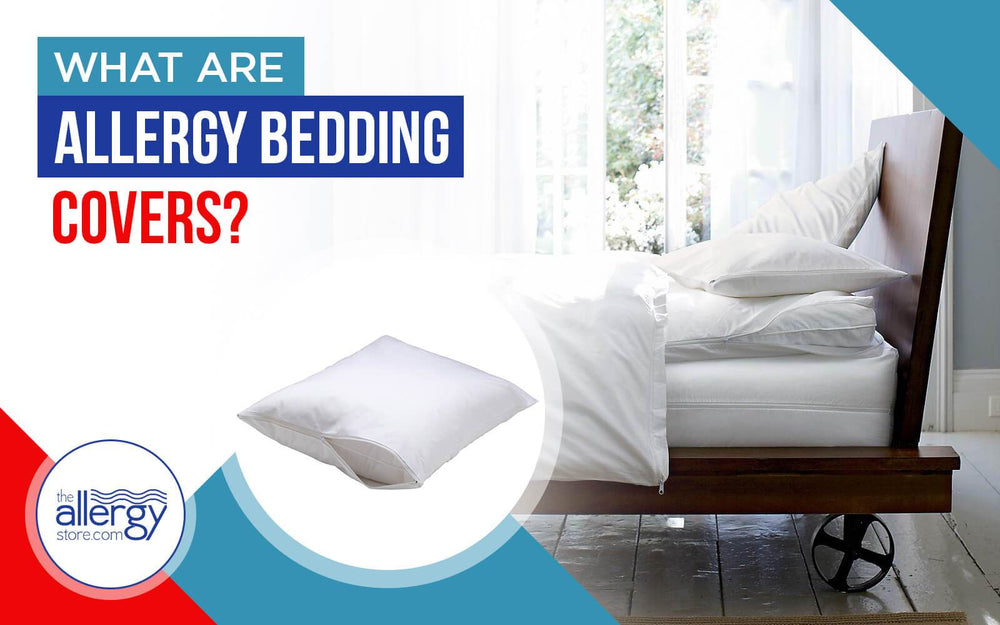
You go to the doctor and they tell you that you have allergies and need to cover your bed. Your search for allergy bedding on Amazon shows all sorts of stuff come up. No help at all.
This is when customers call us and want to know:
- What are allergy bedding covers.
- How do covers work.
- What is the best cover.
Allergy bedding is a term used to set our type of specialty business apart from the big box stores and the regular bedding products being sold in them. Some stores refer to them as dust mite covers, allergy-proof bedding, mite covers or anti-allergen covers just to mention a few.
Allergy bedding = mattress encasings and covers, pillow encasings, duvet covers, featherbed covers and box spring covers that are made to keep dust mite allergens out of your bed or keep the ones already in it from messing with your allergies.
The bed covers we sell for allergies have two very important things in common. Each one is made from a type of fabric, membrane or micro-weave, that does not allow dust mite allergens or bugs to pass through and they fully encase the piece and zip closed.
When covered, your bedding is protected from dust mites, pollen, mold spores, animal dander and even bed bugs and fleas. What is in the bed stays in the bed, the dust mites and bed bugs just die, and nothing else can get into the bed. However an allergy cover will not keep the allergens from getting on top of the bedding.
The covers are really made in two different styles - Membrane, urethane that is bonded to a piece of fabric, and Micro-weave, the fabric is woven so tight it creates a barrier.
Which cover is better and most effective?
It depends on what are you concerned about? The allergens that come from dust mites or pet dander?
The membrane fabric does not allow any allergens to pass. In fact, the urethane membrane actually makes the allergy covers water-proof. This type of cover is the least expensive and we recommend them for children’s beds.
We also recommend this type of encasing for people with bed bug problems. We carry two different allergy fabrics with a membrane, cotton/poly and 100% polyester knit.
Our linen cotton/poly dust mite cover is a 50/50 blend that has been around for years. Cool, comfortable water-proof and very effective.
The 100% polyester knit allergy cover is very soft as well as water-proof. This in my daughter's favorite allergy fabric.
Micro-weave fabrics, the fibers are tightly woven so that they create a barrier against dust mite allergens. How effective these covers will be is based on the pore size, the space between the fibers. Micro-weave covers are the lightest and coolest of the fabrics used for allergy encasings.
Pristine Luxury dust mite allergy covers are made with 100% polyester have the smallest pore size, 5.5 microns, and will hold up the best over time.
AllergyCare 100% Cotton allergy bedding is made from 100% cotton and is a very soft, breathable cover. Being all cotton is has a pore size of 5.6microns.
Do I need to put covers on all of my bedding?
If you want complete protection we do recommend covering the mattress, boxspring and pillow. If you use a comforter we recommend you cover that as well especially if you don't use a top sheet.
There is no need to cover the decorative pillows that you remove from the bed. About once a month take their cover off and put them in the dryer in air fluff for about 10-15 minutes.
Which allergy bed cover is best for me?
The answer to that question can only be answered by you. We even have customers who buy the 6 gauge vinyl covers we sell for box springs to use on their beds. Vinyl will give you 100% protection from dust mites, pollen, bed bugs and is totally water-proof. The real downside is vinyl is so hot. It’s like sleeping on a vinyl couch.
The reason the Allergy Store carries so many different fabrics is so you have a choice. No matter what fabric you chose, you can be confident that it will protect you and your family.
Wishing you the best of health
The Allergy Store

